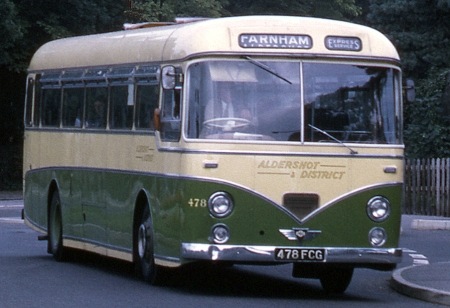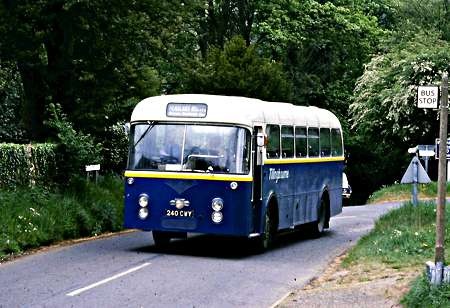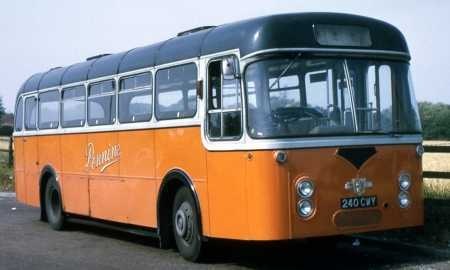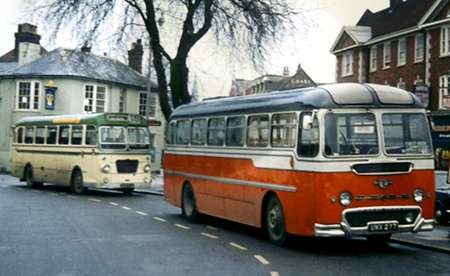Pennine Motor Services
1963
Leyland Leopard L2
Roe B49F
In the 1970s, when I was a manager at London Country, to keep my hand in I used to undertake weekend driving jobs for independent operators. One of these was Tillingbourne, then owned by Trevor Brown, who also dealt in second hand buses and coaches. As well as driving buses on normal service, I would undertake collections and deliveries of vehicles to/from his dealer’s stock. One such trip was the collection of 240 CWY, a Leyland Leopard L2 with Roe B49F body from Pennine of Gargrave (aka Simpson of Gargrave) in August 1975. The picture was taken during a stop “somewhere in England” en route between Yorkshire and Gomshall, Surrey. This Leopard was an early example dating from May 1963, and the Leylands of that vintage always had heavy controls, but I found this Leopard rather nicer to drive than the Halifax examples with very stiff gear change linkage that I had experienced some ten years earlier. 240 CWY served in the Tillingbourne fleet for two years before being sold in October 1977, reputedly to Berresford of Cheddleton, though I cannot find any record of it being run by that operator.
Photograph and Copy contributed by Roger Cox
15/09/11 – 09:25
What an attractive machine this was, and made even more so by Pennine’s stunning livery. I once rode on this vehicle all the way from Skipton (where I’d arrived from Manchester on a Ribble “White Lady” Atlantean) to Lancaster. One of the great bus rides of the day, but sadly no longer available. The last Pennine bus I travelled on was last October between Skipton and Nelson where I connected with a Transdev ‘decker to Manchester. Still a double-deck coach on the Manchester service (although no longer running through to Skipton), still the same lovely Pennine colour scheme, but the Pennine vehicle was a Dennis Dart. Profoundly not the same as the vehicle above!
Neville Mercer
16/09/11 – 09:28
Neville I believe they have a 100% Dart fleet at the moment. I went for a trip on one of them to Burnley and back a few weeks ago. Nice to see them soldiering on, despite competition from Transdev, perhaps 3 journeys per hour from Skipton to Burnley aren’t really needed!
Dave Towers
16/10/11 – 06:42
240 CWY did reach Berresfords at Cheddleton by very early 1978. It was never operated by them but parked up at the back of the garage where it remained basically complete until the site was cleared in the Summer of 1987.
Tim Machin
17/10/11 – 07:39
Their wonderful livery is still well-suited to their Dennis Darts, I’m glad to say. See this link //busestractionengines.blogspot.com/2011/09/pennine-motor-services.html
Chris Hebbron
07/03/12 – 08:36
Hello Roger
Is it possible that the Halifax examples were quite a bit newer when you drove them and would therefore not be as worn? – on saying that I drove PJX 232 which was a ‘B’ fleet vehicle and was allocated to ‘out of town routes’ and the gears were quite easy to select. driving PJX 35 from the ‘A’ fleet was quite different – the gear selection was some what stiffer.
Richard McAllister
17/04/12 – 14:06
240 CWY had a cousin in the fleet, LWU 499D.
I have vague (and only vague) recollection that what is generally known as Simpsons had members of the Windle family on the operating discs in the 60’s. At what point, does anyone, know, did the Simpsons become involved, and are they related to the Windles?
Pete Davies
25/06/12 – 09:00
I enquired above if anyone knew if there was indeed a link between the Simpsons and the Windles, and what that relationship was. I have now managed to obtain a copy of the history of Pennine, published in 2000, which indicates they were in-laws.
Peter has views of MTC 757 and MTD 235 coming in a few weeks, when he’s worked his way through the pile of contributions from others.
Happy viewing!
Pete Davies
25/06/12 – 17:09
Am I alone in seeing a resemblance between the front end of this vehicle and that of the Aldershot & District coaches (bodied by Roe’s sister company Park Royal) which used to operate their London services? Could it be that it was assembled from Park Royal components and “badged” as Roe so as not to offend the sensibilities of good Yorkshire folk? The only other “Roe” examples of this styling that spring to mind are the service buses produced for Leeds. Any former Roe employees from the 1960s out there?
Neville Mercer
26/06/12 – 06:39
Neville, no you’re not alone but it’s hardly surprising since Roe built Park Royal designs on Park Royal frames almost from their take-over. Lincoln had Tiger Cubs which could easily have been PRV/Monocoaches at sight. Until 1968 Roe built all composite bodies to their classic design but also helped Park Royal, out when there were capacity problems, by building their metal framed designs. Don’t think we’re actually that sensitive in Yorkshire. Sheffield had lots of Park Royals from 1963 to the PTE take-over in 1974 and the 1963/4 Regent Vs were almost identical and contemporaneous with the Tracky PD3As of 1965.
David Oldfield
26/06/12 – 06:39
Hasn’t it got the traditional Roe raised waistrail? and wouldn’t that indicate composite construction? Whereas, I’m assuming, the A&D/EKRCC/Birch coaches built by Park Royal would have been of BET-standard steel-framed construction. That aside, the window length was longer, the rear window a curved two-piece structure, and the rear roof dome a different shape. There is some resemblance around the front windscreen though – perhaps Roe did take some inspiration in certain ways, although I’ve just realised that this style of Roe body probably pre-dated the Park Royal (semi) coaches and that any influence might have been in the other direction . . . suitably updated and lengthened.
Philip Rushworth
26/06/12 – 06:40
If this //www.flickr.com/ is the body that Neville has in mind, I don’t think it’s the same one, though it does seem to have the same windscreen.
Peter Williamson
26/06/12 – 11:35
Yes Peter, that’s the one. It was the front-end part of the design I had in mind. Didn’t Great Yarmouth have something similar on Daimler Freelines in the early 60s? This raises another question – why were Gt Yarmouth buying Freelines so late in the production run and a decade after most other UK operators had given the design a distinct thumbs down?
Coming to David’s point, the reason I suggested the “badge engineering” part is that it certainly happened in Lancashire – I’m thinking of Darwen Corporation’s insistence on having AEC designs badged as “Crossleys”. I would never disparage Yorkshire folk, despite the unfortunate events of 500 years ago. In my ideal version of reality Lancs and Yorks would combine to form a new Pennine nation. We are the salt of the earth!
Neville Mercer
26/06/12 – 14:13
I think the answer to your question can be summed up in one word – Hilditch.
Geoffrey Hilditch had firm ideas on what he wanted in a bus and since in those days Leyland had a rather ‘take it or leave it’ attitude, he would go elsewhere if he thought he could manipulate them into producing what he wanted.
So at Great Yarmouth, wanting trusty Gardner engines in his single deckers to match his double deckers, he got Daimler to revive the Freeline. At Halifax he had Dennis remodel the Loline to meet his needs – with disastrous consequences as it turned out – and then went to his old employer (briefly) from his home town and got them to design the Pennine RU (also a disaster). Later at Leicester, disenchanted with British Leyland and the Metropolitans, and really wanting a Fleetline replacement, persuaded Dennis to produce the Dominator.
The last Great Yarmouth Freelines had more of an Alexander type windscreen, similar to the ones Roe had used on their (and others’) Fleetlines, and on the later Doncaster Royal Tiger Cubs.
John Stringer
P.S. A new Pennine Nation eh ? Hmmm………maybe, but there would need to be an East Pennine and a West Pennine I feel.
26/06/12 – 17:50
Yes, but Yorkshire born and bred – and proud of it – I did my degree and first jobs on t’other side. I’d be easy with Pennine Nation. [We have divisions and had Ridings and even Sussex has an East and a West.] We have more in common than not.
David Oldfield
27/06/12 – 07:12
Thanks for that explanation John. I’d forgotten that “Gortonian” was GM at Gt Yarmouth. One of Britain’s truly memorable bus fleet managers unlike say Edgeley Cox of Walsall who I always thought was just plain barmy! On an even more flippant note, despite the Pennine/Skipton connection I would suggest that the capital of our new Pennine Nation should be in Todmorden – part of the town used to be in Lancashire after all.
Neville Mercer
27/06/12 – 07:12

Neville’s point about the resemblance between the Pennine Roe body and the Park Royal coaches of Aldershot and District may be seen in this view of A&D Reliance 478, 478 FCG, with C49F body delivered in 1963. These fifteen vehicles were of the 4MU4RA type with the AH470 7.685 litre engine coupled to a six speed constant mesh gearbox. It would appear that the windscreens are identical, but the waistrail level and driver’s side window are set at a lower level on the Park Royal. This picture was taken in Farnborough, where I then lived, in August 1969, by which time the magnificently florid traditional Aldershot and District fleetname had been replaced by the simpler style shown.
Roger Cox
27/06/12 – 13:36
I think the A & D coaches (and livery) looked better than the East Kent – good in itself – but I still prefer the 2U3RA, despite its troublesome AH590 engine.
David Oldfield
08/07/15 – 05:35
I drove 240 CWY when the vehicle passed to Tillingbourne Bus Company which sadly abruptly closed a few years ago. I would regularly drive part time driving for them based at Gomshall railway station where they operated local village services into Guildford. 240 CWY was heavy on the steering but a good bus to drive. I spent many a happy hour trundling in and out of Guildford to Peaslake and Farley Green making sure I got in front of the London Country MB’s running into Guildford in the 1970’s. I went on to have my bus company Leisurelink at Newhaven.
Clifford Jones
09/07/15 – 07:44

Attached is an image from my slide of 240 CWY in service with Tillingbourne leaving Gomshall for Peaslake and about to cross the level-crossing on the Guildford to Dorking line.
I recall that Tillingbourne acquired 4 vehicles from Pennine, a second Leopard LWU 499D and a pair of Tiger Cubs 6108 WU and 9712 WX. Nearby Tony McCann of Forest Green also acquired a Tiger Cub UWX 277 which ran in Pennine colours for some time.
Happy days.
Keith Newton
10/07/15 – 06:53
I collected one of those Duple Donington (often misspelt – only three ‘n’s in the word) DP41F Tiger Cubs PSUC1/2 from Gargrave, Keith, and also drove them all (another PSUC1/2 Donington came from Thomas, West Ewell) in Tillingbourne service. The Tiger Cub was quite a nice machine to drive, certainly superior to the early Halifax Leopards, and the Donington was one of Duple’s better bodies in my opinion. I have a picture of one in Tillingbourne livery somewhere. I must seek it out. The Guildford – Dorking – Redhill railway line is a delight, following as it does the foot of the North Downs all the way. For seven years I used it to get to work between North Camp and Reigate – BRCW Type 3 loco hauled in the morning, and Tadpole demu unit back home in the afternoon. Happy days indeed.
Roger Cox
11/07/15 – 07:19
I worked outside Guildford station in 1961/62 and reczll the extensive steam depot there, unusual in an otherwise electrified area. Around 1980, I took a Tadpole from Guildford to Ashford, along a disturbingly straight track! The ‘Tadpoles’ coaches never matched, being cobbled together from narrow straight-sided Hastings stock and surplus rounded Tyneside stock. Some of the Type 3’s were narrow, too, to squeeze through the Hastings tunnels!
Will look forward to seeing the photo, Roger, if you can find it!
Chris Hebbron
 Vehicle reminder shot for this posting
Vehicle reminder shot for this posting
09/08/15 – 14:05

I can now attach an image of UWX 277 in Horsham Sussex with Tony McCann. Behind is the former Western National SUL with Tillingbourne. Not a good advert for independent operators in those days!!!. Apologies for the poor photo but there were problems at the time with film and the slide has faded. There is a better – black and White photo [not mine] – in Laurie James’s book on Horsham’s Independent Bus Services and apparently UWX 277 was nicknamed the Orange Box.
Keith Newton

Leave a Reply